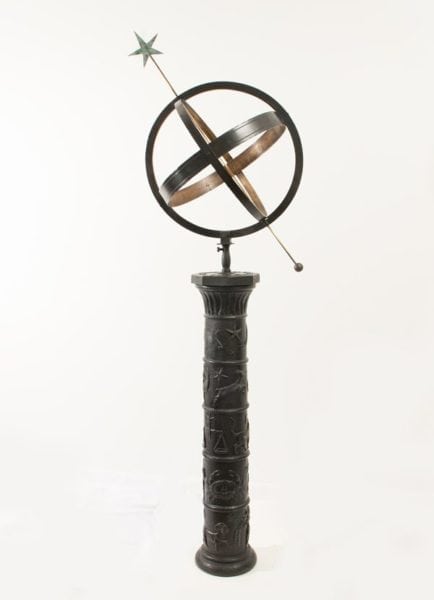Designed 1921, cast circa 1925 by Näfverkvarns bruk, the patinated bronze armillary sphere with engraved calibrations, the cast-iron shaft with embossed celestial and Zodiacal motifs 71 in. high, 19¼ in. diameter sphere cast designer’s mark and date ‘1921’ (base column)
Examples of this design were exhibited at the Göteborg Exhibition, 1923
By the early 20th century, cast iron was generally considered an old-fashioned medium best relegated to mundane applications like lamp posts. In the 1910s, the Näfveqvarns Foundry of Sweden , which had been casting iron for hundreds of years, was now headed by a dynamic new director that invigorated its production with new techniques and models that, against the odds, managed to make cast iron chic again.
In 1912, Näfveqvarns collaborated with the Swedish Society of Craft and Industrial Design (a body founded in the nineteenth century to improve design standards in Swedish industry) on a competition that opened the design of new models to outside talent. Soon a number of the era’s rising talents, such as architects Folke Bensow, Gunnar Asplund, Uno Åhrén and Carl Hörvik, and sculptors, such as Ivar Johnson, Anna Petrus, and Erik Grate, were designing furniture, decorative plaques, urns and other pieces for the Foundry.
The partnership with these artists resulted in some of the most iconic and original examples of the “Modern Classicism” aesthetic that dominated Swedish design in the 1920s. A sleek and lyrical take on the classical tradition, the style took its cues from the various forms of classical revival that had been popular in Sweden since the late 18th century, rationalizing and rearranging them for 20th century life.
Through publications and exhibitions, Näfveqvarns garnered international acclaim, with models displayed at Hemutställningen in 1917, the Jubilee Exhibition in Gothenburg in 1923, the Paris Exposition of 1925, as well as a follow-up exhibit at the Metropolitan Museum of Art in the same year.
Although the Foundry eventually ceased its artistic production, the pieces it created during the first half of the 20th century are today prized by collectors for their unique voice in the history of design.

